Crawfish farming practices are based on annual hydrological cycles and conditions, to which the crawfish have become adapted – namely, seasonal flooding and drying, with the dry period usually occurring during the summer. Pond inundation, or flooding, begins the chain of events that establishes the environment from which crawfish obtain most of their nutrients. Crawfish are not routinely fed pelleted rations. Rather, the production strategies in Louisiana and other southern states rely on a forage-based system for providing nourishment to growing crawfish.
A forage-based production system benefits crawfish indirectly by supporting a complex ecological community of invertebrates, which the crawfish then consume as high quality food sources. The invertebrate community that is so important to crawfish relies on a continual influx of plant fragments that are in turn consumed by bacteria and other microorganisms. Put simply, the forage crop serves as the fuel for a food web, with crawfish at the top of the food web.
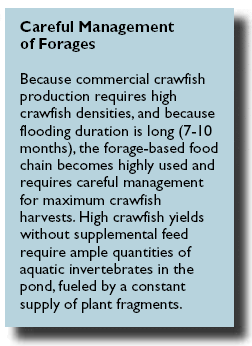
A continual supply of vegetative matter for decomposition is necessary throughout the production season to feed the invertebrate population. This requires a forage crop that yields small portions of its material on a consistent basis over the duration of the season. Too much vegetative input into the system at one time is wasted because it cannot be stockpiled; thus, a large portion deteriorates without being consumed. Also, excess contribution at one time leads to premature depletion of the food resource and can cause low oxygen conditions. Too little vegetative detritus can result in actual food shortages for the organisms that crawfish rely on as high quality food items and, therefore, food shortages for crawfish.
Crawfish farming, as practiced in Louisiana, requires a forage crop that provides plant matter to the underwater food web consistently throughout the growing season. In general, voluntary stands of vegetation perform this task poorly. Terrestrial grasses make for a poor crop because much of the stand is killed upon flooding, negatively affecting water quality and providing short-lived detrital resources (Figure 1). Because of the adaptations of rooted aquatic and semi-aquatic plants such as alligatorweed (Alternathera philoxeroides) (Figure 2), smartweed (Polygonium spp.) and others, fragmentation is usually inconsistent and often seasonal. Much of the vegetative biomass of hardy aquatic plants normally remains alive and above water and is unavailable to the food web except for seasonal events such as killing frosts, which often make it available in excess quantities and at times (winter) when it can be least utilised.
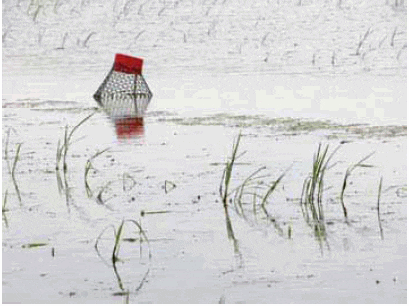
Despite the inadequacies of individual plant species in a volunteer stand, the right mixtures of native plants can have a complementary effect and do occasionally produce acceptable crawfish yields. With voluntary stands of vegetation, however, the appropriate mixture of species is very difficult to obtain on a consistent basis. Furthermore, some native plants tend to become so thick they impede harvesting efforts and/or efficiency. Pond warming during spring, and often water circulation, can be slowed by thick stands of plants. Moreover, many voluntary species are considered noxious weeds and are undesirable in fields where agronomic crops will be grown during subsequent years.
Planted agronomic crops routinely have been the most effective forage resources for crawfish ponds. They are effective partly because these plants exhibit the desired characteristics under the long-term flooded condition of a crawfish pond and partly because adequate stands of vegetation are achievable and predictable when recommended management practices are followed.
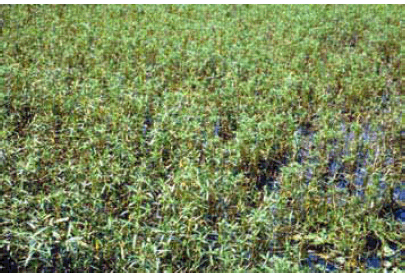
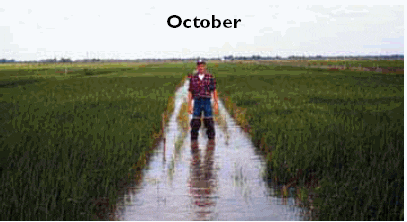
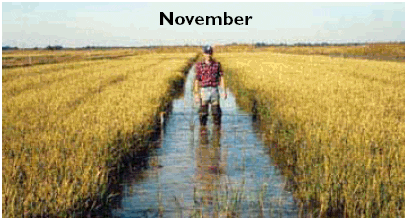
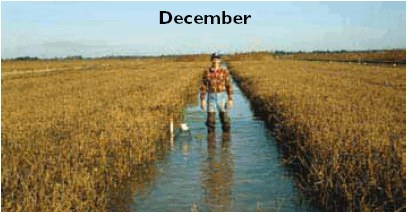
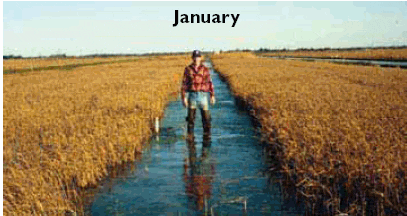
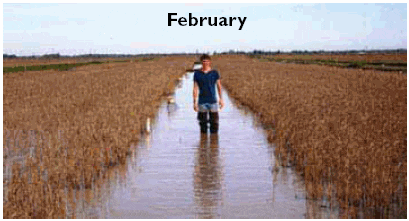
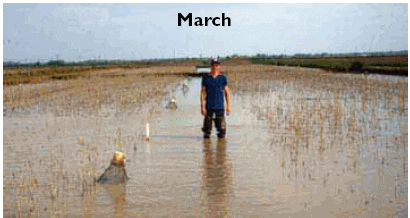
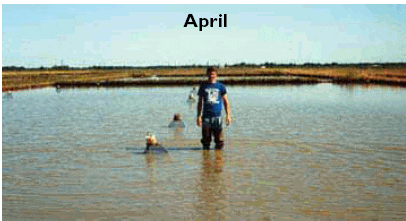

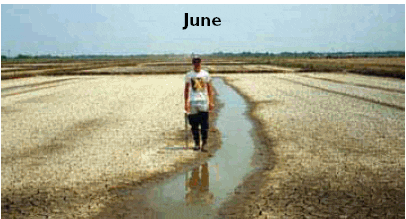
Rice (Oryza sativa) has become the standard forage crop for the industry (Figure 3). Because of its semi-aquatic nature, rice tends to persist well in flooded crawfish ponds, yet it furnishes plant fragments to the detrital pool in a consistent manner. Sorghumsudangrass hybrid (Sorghum bicolor x S. sudanense) is also used successfully (Figure 4). Millets (browntop, Japanese, proso and pearl cultivars), grain sorghum and soybean stubble also have been examined as possible forage crops, but all these plants demonstrate limited potential for crawfish production when compared to rice or sorghum-sudangrass.
Agronomic plant type and management considerations for maximum yield in crawfish ponds depend on the type of culture system used for growing crawfish. Although basic cultural requirements and practices for producing crawfish are similar regardless of management approach, different production goals dictate different management concerns. This consideration particularly applies to the forage crop and its management. Information regarding recommended practices for planting and management of forage crops can be found in publications such as the Louisiana Rice Production Handbook (Pub. 2321) or by contacting your local LSU AgCenter extension agent.
Monocropping Systems
In crawfish monocropping systems, choice of plant species/ variety and time of planting are the most important considerations regarding forage management. Aside from relying on voluntary vegetation, choices for maximum benefit are limited mainly to rice or sorghum-sudangrass hybrid, and the choice usually depends on personal preference and logistical considerations. Rice is the most widely used of the two, and variety selection is primarily based on forage characteristics rather than grain traits. Unless waterfowl hunting is part of the overall management goal, grain production in the crawfish forage crop is not desirable.
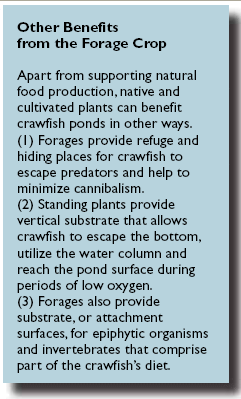
Until 2004, rice variety selection for use in crawfish ponds had been limited to those varieties developed for grain production. Rice breeders have consistently developed rice varieties for grain production that have high grain-to-forage ratios, are shorter in plant height and are earlier maturing – characteristics that, although desirable for high-yielding grain crops, are less desirable in a crawfish forage crop. Desirable traits for rice used in crawfish ponds include high forage biomass production, lowtemperature tolerance, longer maturity cycle, high resistance to lodging, slow senescence (breakdown) rate, disease resistance and propensity for plant re-growth in spring.
In 2004, the LSU AgCenter released the first rice cultivar developed specifically for use in crawfish monocropping systems. “Ecrevisse” was the culmination of years of screening and evaluation of rice genotypes originating around the world, and selection of one line that was further improved (purified) under Louisiana’s growing conditions. This new variety exhibits much greater forage biomass production, better persistence under the extended flood conditions of a crawfish pond and has a greater propensity for post-winter regrowth than the commonly used domestic varieties (Figure 5). Because of the selection criteria used and the methods employed for further development of this variety, there was an inherent selectivity for disease resistance and adaptability to South Louisiana’s soil and environmental conditions. Therefore, until a better variety is found, this new variety should be the hands-down choice for establishing a rice forage crop in crawfish monoculture ponds in Louisiana. Ecrevisse is almost certainly limited to crawfish monocropping systems, however, because it is a short grain rice and exhibits poor milling traits, making it less desirable for use in grain markets.
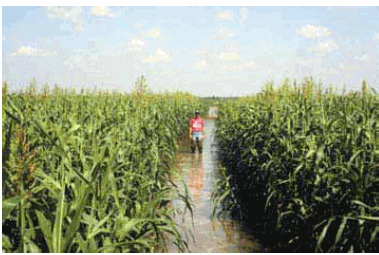
Selection of rice varieties other than Ecrevisse for establishment in crawfish monocropping ponds is currently limited to commercially available high grain-yielding varieties. Recommendations from commercially available varieties are scant because few comparative studies have been made regarding their suitability in crawfish ponds. New varieties are released and adapted so often that it is impractical to investigate thoroughly each one within the different regions where crawfish are grown. In general, those varieties that are well-adapted to local conditions, are taller, have a longer maturity cycle, tiller well, produce abundant forage biomass and senesce slowly are likely to be the best choices for planting in crawfish ponds. In theory, supported only by preliminary research, it may be beneficial to mix several varieties when planting in crawfish ponds. Differences in post-flood characteristics of different varieties, such as fragmentation rate, crop persistence and re-growth potential may provide detrital material to the pond on a more consistent and extended basis than a forage crop composed of only a single variety.
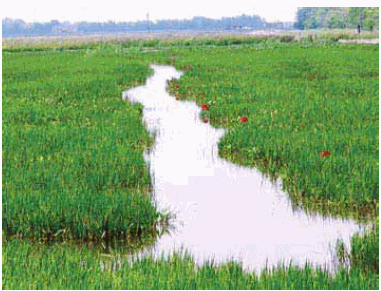
It has also been demonstrated that sorghum-sudangrass, commonly used by cattlemen for grazing and hay, is a well suited alternative forage crop for crawfish monocropping systems. It grows rapidly, can produce nearly twice the amount of forage biomass as rice, is very hardy and drought resistant and may prove more reliable in some cases than rice when a stand must be established in late summer. This crop, if managed properly, also exhibits good persistence in crawfish ponds with consistent fragmentation of material well into the season. One of the main benefits of sorghum-sudangrass over rice is that it does not require as much moisture for optimum growth. An adequate rice crop can rarely be achieved without some irrigation during the summer growing phase in Louisiana. Conversely, sorghumsudangrass may need little or no irrigation and, in fact, cannot tolerate saturated soils for an extended period while in its early growth stages. Another potential benefit of sorghum-sudangrass over rice is that it has a later recommended planting date. Because of its rapid growth potential, when the optimal window for rice establishment has passed, forage stands can often still be established (or salvaged) by planting sorghum-sudangrass.

Regardless of which agronomic crop is chosen for use in crawfish monocropping systems, time of planting is extremely important. For best results, when waterfowl hunting is not a consideration, it is essential to plant early enough in the summer to achieve maximum vegetative growth, but not so early that the plant reaches full physiological maturity. A forage crop that matures or “fills grain” prior to the onset of winter tends to senesce more rapidly (Figure 6), often resulting in early depletion of the forage resource and subsequent stunting before the crawfish season’s end. In South Louisiana, the most appropriate planting time for rice for crawfish forage is during the first two weeks of August. For sorghum-sudangrass, optimum planting time is generally in the last two weeks of August.
Recommended planting dates tend to be earlier in more northerly areas. If a crawfish producer anticipates flooding early (prior to mid-October) or grazing or baling of the crop, earlier planting of sorghum-sudangrass should be considered. When waterfowl management is an important component of the farming practice and seed formation in the crawfish forage crop is desired, species selection and/or planting dates may need to be altered. In most situations, however, it is difficult to manage for maximum benefits in the crawfish forage crop while managing for waterfowl hunting.
Adequate stand establishment is another important aspect of forage management. Even under the best of situations, early depletion of the forage resource can occur, especially with high populations of crawfish (Figure 7). Nevertheless, to ensure maximum benefit from the forage crop, starting with an ample stand of forage is essential. Regardless of plant type chosen, when dry-seeding forage for crawfish, good stands are easier to achieve in well-tilled seedbeds. Water seeding is also a common method for the commercial planting of rice; however, achieving proper stands can be difficult with this method during the summer heat. High water temperatures can impede germination or stifle survival of young seedlings.
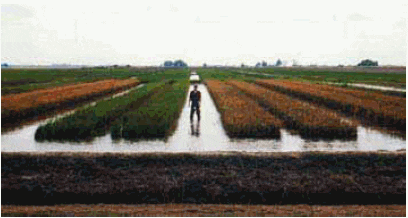
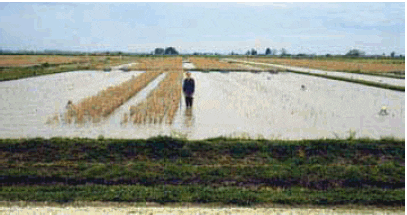
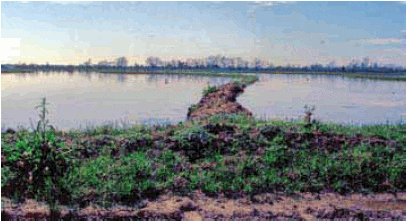
Water (or moisture) management is an important consideration for both water- and dry-seeded fields. Rainfall after planting is the preferred means of obtaining and maintaining moisture, but in the absence of timely rains, irrigation may be needed. As with water seeding, standing puddles of water after planting can contribute to poor stands of forage in dry-seeded fields. Permanent, but shallow, floods usually can be established in rice forage crops when the rice plants are tall enough (2-4 weeks after planting) to withstand standing water. If the pond contains minimal amounts of terrestrial weeds that would not contribute to water quality problems when flooded, a shallow flood is desirable. Water levels can be slowly increased as the rice grows until full flood depth is reached in the fall. Establishment of the permanent flood in crawfish ponds planted with sorghumsudangrass, however, should be delayed until the forage crop has stopped growing or the optimal flood-up date (typically October 15) is reached.
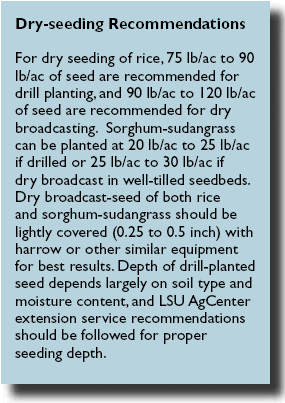
With any agronomic forage crop and with most soil types, some fertilisation will likely be needed for optimum forage production. Normally, on lighter soils at least 40-60 units of nitrogen (N) and a lesser amount of phosphorus (P) and potassium (K) are usually required, but a soil test is recommended for determining exact needs. Other soil amendments, such as agricultural lime, are sometimes needed but depend on several factors, including forage crop, soil type and chemistry and water characteristics. They should be determined by soil (and sometimes water) testing. Soil and water samples can be analysed by the LSU AgCenter’s Soil Testing and Plant Analysis Laboratory for a nominal fee. Contact your local LSU AgCenter extension office for instructions on submitting soil and water samples for analysis.
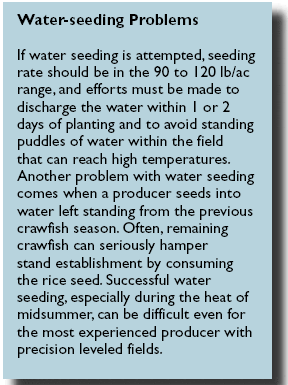
Pesticide management in the forage crop should be dictated by needs on a pond-by-pond basis. In crawfish monocropping systems where grain production is not the desired outcome, chemical weed control should only be undertaken when weed type and density threatens the health of the forage crop. The presence of some weeds in the forage crop is not detrimental and may even be desirable if the weeds act in a complimentary nature to the forage crop. For example, limited amounts of alligatorweed, well dispersed in a pond, are often beneficial. As the rice crop diminishes during the later part of the season, alligatorweed usually thrives in the warming water, providing shelter, substrate and some food value to the pond.
Insects, especially fall army worms, and diseases also can affect forage crops. Very few pesticides, however, can be used in crawfish ponds. Pond flooding can be an effective alternative treatment for armyworms in rice but this strategy is usually not a suitable option in sorghum- sudangrass. Aside from the chemical label restrictions linked to pesticide use, concerns also are associated with the exposure of crawfish to many chemical compounds. Although the crawfish are likely protected within the burrow from most legal pesticide applications on dry ground, extreme caution and knowledge should be exercised when making any pesticide application. The LSU AgCenter extension service or other knowledgeable professionals should be consulted when questions about pest problems arise.
Rotational Cropping Systems
Multicropping of rice and crawfish requires different forage management strategies than monocropping systems. Different crop types are not an option, because crawfish always follows a rice (for grain) crop. Rice variety selection is limited under this production strategy because of the grain production requirements. Rice varieties are generally chosen for their grainyielding and milling characteristics rather than forage characteristics, which tend to be inconsistent with those traits needed for high density crawfish production. Under moderate densities of crawfish, however, many high grain-yielding rice varieties are sufficient. For maximum benefit under high population densities, rice variety selection in a multi-cropping strategy should also take into consideration the ratooning characteristics of the variety. Residual straw and stalks in harvested rice provide little long-term benefits in terms of food resources. The bulk of the required forage base is derived mainly from ratoon or re-growth of the rice stubble after grain harvest.
Within the confines of best yielding (and milling) rice varieties, consideration should also be given to those varieties with a high propensity for ratoon forage production (Figure 8). Commercial rice varieties are constantly changing as new and improved lines are released; therefore, variety selection should be based on the best available information, which is usually obtained from LSU AgCenter extension personnel or publications such as “Rice Varieties and Management Tips” (Pub.2270), published annually by the LSU AgCenter Louisiana Cooperative Extension Service.
Management of the forage crop for crawfish under a rotational strategy is principally related to ensuring proper re-growth from the ratoon crop and minimising the negative effects on water quality from breakdown of straw and debris from the grain harvest. As with crawfish monocropping systems, fertilisation and irrigation is often needed to ensure maximum forage production. Because of previous applications of phosphorus and potassium in the main rice crop, subsequent applications may not be necessary, but often additional applications of nitrogen are required for maximum response and re-growth. Soil tests and/or advice from a professional should aid in determining exact nutrient amendments needed for each situation.
Rice stubble responds best to applications of fertiliser, followed by irrigation, shortly after grain harvest. Extended delays in supplying moisture to the stubble during dry conditions can result in poor re-growth. Also, periodic irrigation or, as with crawfish monocropping, maintaining a shallow flood may be warranted to ensure adequate moisture and uptake of nitrogen applications. Water quality will deteriorate quickly, however, with a constant flood due to high amounts of decomposing plant matter and must be improved before crawfish begin to emerge. Improved quality can be accomplished by water discharge or allowing for complete evaporation, followed by refilling, often several times. Since most rotational cropping occurs in precision-leveled fields, the most efficient means of water and forage management prior to establishment of the permanent flood is to implement a shallow flood (2-4 inches deep) and allow for evaporation, with water replenishment before the soil becomes too dry.
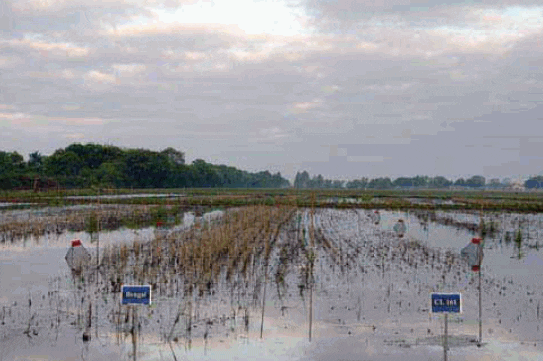
To further minimise water quality concerns, the straw and debris left from grain harvesting operations can be baled and removed, burned or chopped (to speed degradation). Those practices should occur during or immediately following grain harvest and before applying fertiliser and water. Timely rain or irrigation is essential for proper re-growth and also aids in partial decomposition of dead plant material that can cause water quality problems upon flooding for crawfish. Nonetheless, timing of the permanent flood should be delayed in these systems until cool weather persists. This is usually early to mid-October or later in South Louisiana. As with crawfish monocropping systems, weed-free fields are not necessary for adequate crawfish yields, and caution should be exercised anytime pesticide applications are contemplated.
Post-Flood Management of the Forage Crop
Regardless of the production strategy employed or forage type used, few forage management options are available, or needed, following crawfish pond flood-up. For ease of harvesting, some producers choose to establish trapping lanes in the forage crop prior to flood-up. Lanes can be established by mowing, disking or dragging a heavy object in a path where boat “runs.” Other farmers elect to establish lanes, if needed, after flooding by repeated trips with a harvest boat. For best results, trapping lanes should be constructed so that traps rest squarely on the bottom to optimise catch efficiency. Forage biomass persistence, especially with rice, can sometimes be improved by minimising flood depths. In general, with the exception of some aquatic plants, the deeper the water depth is maintained in ponds, the more rapidly the forage crop will be depleted. Forages also can become depleted prematurely when crawfish biomass is high or when the crop matures and forms grain prior to winter. Grain formation, aside from coinciding with increased breakdown rates, often attracts birds that, in high numbers, may physically break down the forage crop prematurely.
Rice crops, especially immature stands, may have a tendency to resume growth when temperatures warm sufficiently in the spring, provided living stalks survive the winter and crawfish density is not exceedingly high. This new growth can be critical in providing additional food resources at a time when they are needed the most. To encourage spring re-growth, however, pond managers may need to lower the water level in turbid waters to expose viable nodes on the rice stalk to warmth and sunlight. Lowering water level is an important, but often overlooked, management strategy that increases food resources and can sometimes prevent stunting.

